Spongy moth biology
The spongy moth's life-cycle stages are best managed in specific ways. You may come across eggs, caterpillars, cocoons or adult insects and want to identify whether they are spongy moths by using the following information.
Spongy moth life cycle
Click on the part of the life cycle you want to learn about.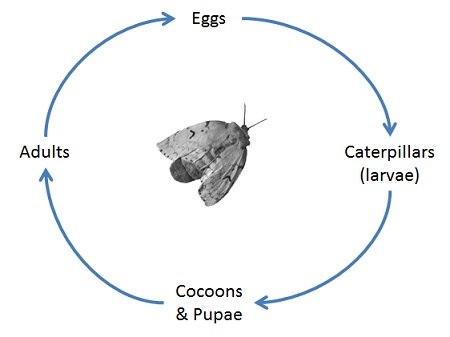
Eggs
Egg description
Eggs are laid in, on or inside trees — or on any solid object found under a tree such as lawn furniture, toys, vehicles or piles of wood or lumber. Egg masses can be transported over long distances when the materials the eggs were laid on are moved. Infestations can then spread slowly, when spring breezes blow young larvae across a few kilometers at a time.
The adult female spongy moth lays eggs in masses in August and September. She covers the eggs with buff-coloured hairs, making the egg masses look like small pieces of cloth. The eggs hatch in the spring.
Look for the buff-coloured, spongy egg masses on the sheltered portions and crevices of items that are under or near trees. This includes all:
- Outdoor equipment
- Outdoor furniture
- Outdoor toys and playground equipment
- Fences
- Tree trunks
- Wood and lumber piles
- Garden sheds and other gardening equipment
- Recreational vehicles (RVs, boats, trailers)
- Any other object that was stationary in the area during the months of July through August when the adults are reproducing
Eggs can be moved easily from one place to another. Examine your belongings before moving them to ensure no gypsy moth eggs are present.
Identification images
Spongy moth laying eggs
The white female spongy moth laying eggs on the bark of a hardwood tree:
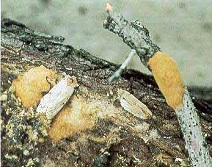
Egg mass
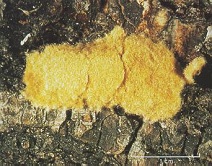
Caterpillars (larvae)
Spongy moth caterpillar characteristics
Spongy moth caterpillars:
- Are hairy
- Have distinctive rows of paired red and blue tubercles (bumps) along their backs when fully grown
- Are big – when fully grown, about the size of your little finger
- Do not move like an "inchworm," with their middles rising up and their two ends coming close together
- Hatch in early May and grow through the summer
- Do not form tents of webbing in trees – or leave behind much webbing at all
- Rarely feed on coniferous (evergreen) trees, except when in large populations and other food is scarce
Larvae life cycle
Tiny larvae, or caterpillars, hatch from eggs between early and mid April. The caterpillars are responsible for the damage to trees and plants during a spongy moth infestation.
The newly hatched, small, hairy caterpillars move up host plants to eat the newly emerged leaves. At this stage some can be blown by wind to new locations. Their light bodies can travel several kilometres when the wind catches the small threads of silk they make using glands in their heads. This spring "ballooning" is one of the key ways that a gypsy moth infestation can spread to new areas.
spongy moth caterpillars grow and change over a couple of months. They reveal a new look each time they shed their skin. By early July, they are fully grown and ready to pupate (transform to an adult within a cocoon).
While younger larvae feed mostly at night, older larvae feed day and night. A single caterpillar can eat up to 1,000 square centimetres of foliage in its lifetime, the equivalent of 15 oak leaves.
Mature caterpillars are about six to seven centimetres long, darkly coloured, and quite hairy. Each has a double row of tubercles (bumps) along its back. They usually have five pairs of blue and six pairs of red tubercles, but sometimes all tubercles are either black or blue.
Many people are allergic to gypsy moth caterpillars' hairs, developing skin rashes or respiratory problems when exposed.
Most Common Spongy Moth Host Trees
There are more than 300 known hosts of the North American strain of the European spongy moth.
Native trees
- Alder
- Birch
- Cherry
- Dogwood
- Douglas-fir
- Hazelnut
- Hemlock
- Juniper
- Larch
- Maple
- Oak
- Pine
- Poplars
- Some cedars
- Some true firs
- Trembling aspen
- Willow
Introduced trees
- Apple
- Apricot
- Ash
- Beech
- Cherry
- Chestnut
- Elm
- Hawthorn
- Holly
- Linden
- Oak
- Peach
- Pear
- Plum
- Redwood
- Walnut
Identification images
Newly hatched caterpillars
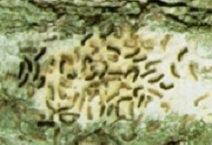
A younger caterpillar
Note the hairy body and the coloured spots on its back.
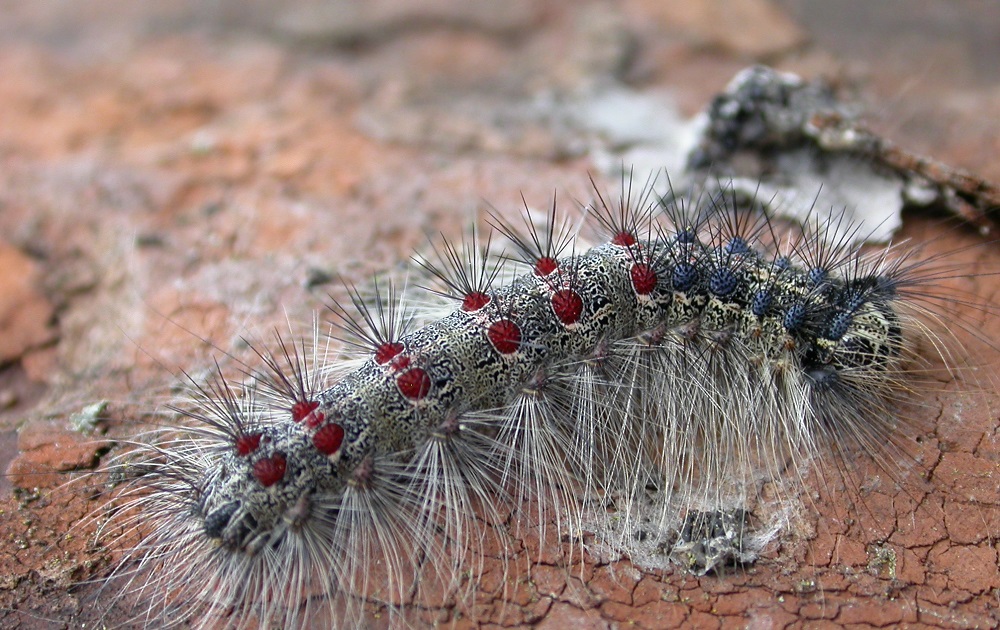
An older caterpillar
Note that the coloured spots on its back are more obvious. Also note the distinctive markings on the head.
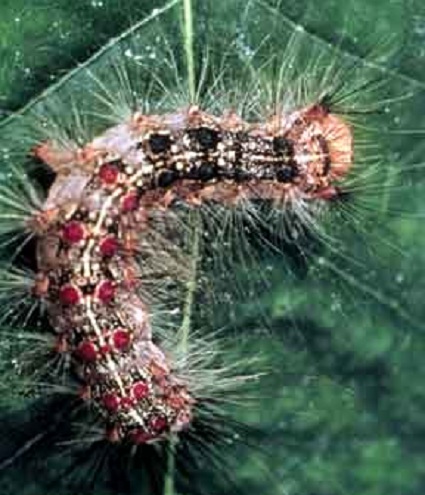
Cocoons and pupae
Description
Feeding is usually completed by late June or early July. Most larvae then move to sheltered locations such as bark crevices. There, within cocoons, they transform into adult moths — a process called pupating. Pupating takes about 10 days for a female and 13 days for a male. All caterpillars in a population pupate within a month, usually during July.
The pupae are dark reddish-brown, usually with a few yellowish hairs. Female pupae are much larger than male.
Identification images
An empty cocoon
Note cast-off caterpillar skin to the right of the cocoon.
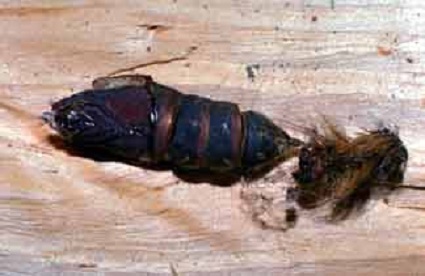
Adults
Moth description
Moths — the adult stage in the spongy moth life cycle — start emerging from their cocoons in late July. This emergence can continue into late August in south-coastal B.C.
Adult spongy moths do not eat. They live only about a week — long enough to mate and for the females to lay their eggs.
Male spongy moths are brown. They have a small body and are strong fliers. Female spongy moths are white with black markings on their wings. They are much larger than males and do not fly.
Females attract mates using chemicals called pheromones. After mating, the female lays her eggs before she dies. Her eggs will hatch the following spring. Egg-laying is usually complete by early September.
Identification images
Adult male Spongy moth
Note the feathered antenna.
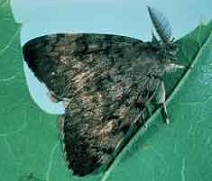
Adult female Spongy moth
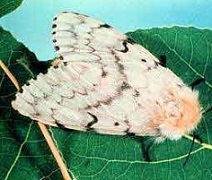
What can you do?
If you find any of the spongy moth life stages, please contact the Canadian Food Inspection Agency (CFIA) as soon as possible. An inspector will investigate.
- 250-363-3618
(Vancouver Island) - 604-666-2408
(Mainland/Interior)
Not sure if you have found a Spongy moth?
- Review the details about the spongy moth life stages here
- Get help identifying whether a caterpillar is a spongy moth caterpillar.
Contact information
Contact us if you have further questions about the spongy moth or how the species is controlled in B.C.
